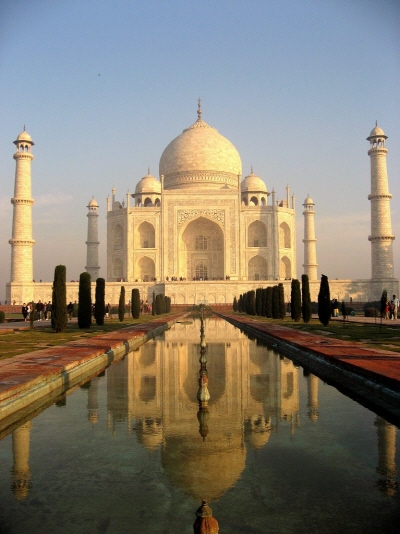
인도의 타지마할이 세계 7대 불가사의에 속한다는 사실은 누구나 한 번쯤 들어본 이야기이다. 하지만 '왜'라고 물으면 조금 난감하다. 나
역시도 페루의 마추픽추, 이집트의 피라미드를 포함하여 7개 항목을 줄줄 외울 수는 있어도 '왜 불가사의 한가?'에 대해서는 깊게 생각해 본 적이
없었다. 이런 에피소드를 포함하여 세 번째 인도 방문에서 비로소 알게 된 타지마할의 숨겨진 이야기들을 소개하고자 한다. 매번 방문할 때마다
새로운 이야기를 들을 수 있고, 이것이 차곡차곡 더해져 감상의 재미가 깊어지는 것이 유적지의 가장 큰 매력이 인 듯하다. 당신이 모르는, 세계
7대 불가사의 '타지마할'의 스토리로 빠져보자!
1. 타지마할은 왜 만들어 졌는가?
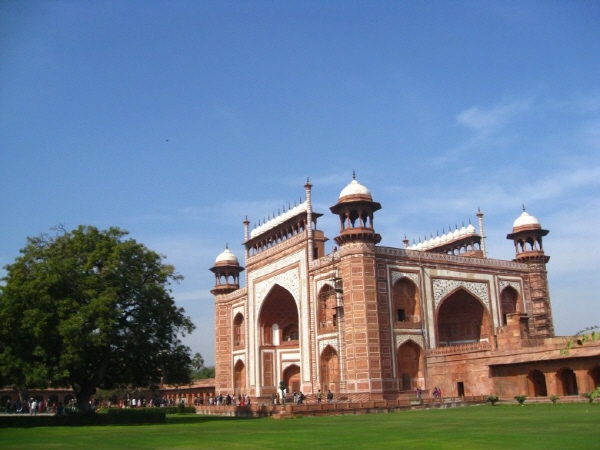
타지마할을 세계에서 가장 아름다운 건축물 중 하나로 뽑는 이유는 아름다운 외관에 애틋한 배경 설화가 녹아 들어가 있기 때문이다. 매력적인 외모에 이끌려 만났는데 알고 보니 마음마저 착한 격! 무굴 제국의 5대 황제였던 샤 자한(Shah Jahan)이 가장 사랑했던 세 번째 부인 뭄타즈 마할(Mumtaz Mahal)은 15번째 아이를 낳다 죽고 말았다. 39세의 젊고 아름다운 나이였기 때문에 왕은 며칠 만에 머리가 하얗게 셀 정도로 큰 슬픔에 빠졌다. 뭄타즈 마할은 정략결혼이나 부모의 소개가 아닌, 연애로 맞이한 부인이었기 때문에 유독 그녀의 대한 사랑이 각별했다고 한다. 상심한 왕은 부인만큼 아름다운 건축물을 그녀와 연애할 동안 자주 만났던 곳에 지어 평생 추모하기로 결심한다. 1632년부터 이탈리아, 이란, 프랑스, 터키 등 세계 각국의 기술자와 건축가 2만 명을 동원하였다. 야무나 강을 뒤로 눈부신 백색의 대리석으로 본관을 짓고 갖가지 보석으로 장식을 하였다.
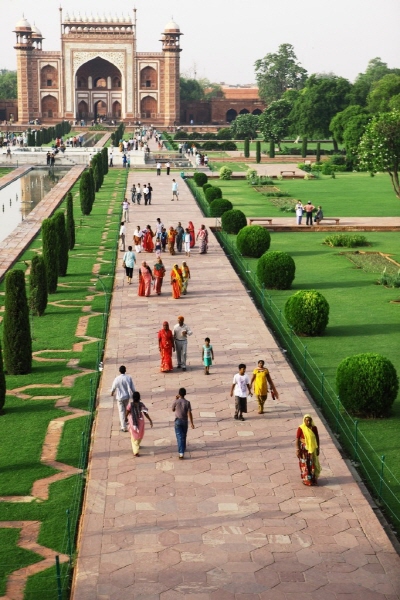
▲ 300m에 달하는 본관 앞의 정원
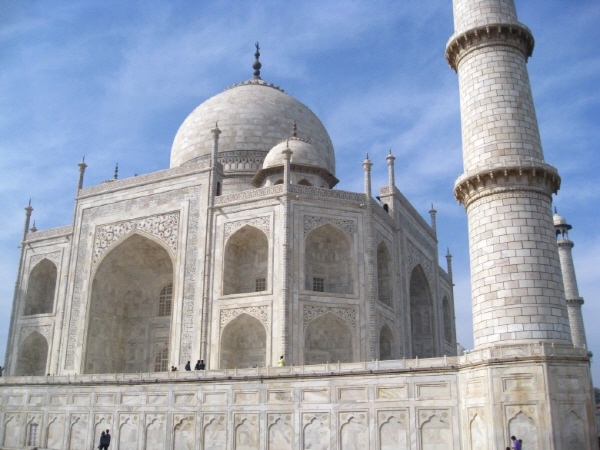
22년간의 긴 공사 끝에 78m의 높이에 달하는 신비로운
팔각 건물이 완성되었다. 이후 다시는 이런 건물을 만들 수 없도록 기술자들의 손가락을 잘랐다는 이야기도 전해진다. 왕은 이 건물을 보자 부인의
이름인 '타지마할!'을 나지막이 외쳤고, 이로써 왕비의 이름이 건물의 이름이 되었다.
2. 샤 자한 왕은 한 번도
타지마할에 들어가 본 적이 없다?!
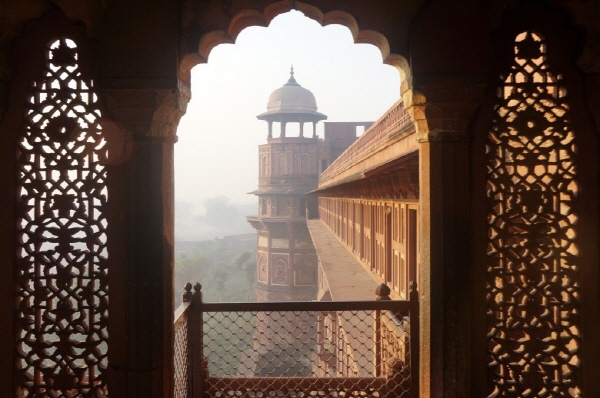
22년간 타지마할의 완공을 누구보다도 애타게 기다렸을 샤 자한 왕은 평생을 두고 단 한 번도 타지마할에 들어가지 않았다. 죽은 부인 생각에 너무도 침통해서일까? 슬프게도 샤 자한 왕은 자신의 친아들 아우랑제브(Aurangzeb)가 형제들을 모두 죽이고 황제로 등극하는 난을 일으켜 생의 마지막 8년을 유폐된 채 보낸다.
사자한 왕이 갇혀 있던 아그라 요새의(Agra Port) 무삼만 버즈(Musamman Burj) 탑에 서면 저 멀리 타지마할이 아련히
보인다. 혹자는 샤 자한 왕의 유폐 이유가 타지마할 옆에 또 하나의 검은 대리석 궁을 지으려고 했기 때문이라고 한다. 이미 타지마할을 지으며
국력을 탕진한 상태에서 계속 과거의 향수에만 집착하는 아버지를 아들이 제지한 것이다. 이러나저러나 한 시대를 통치했던 사자한 왕의 로맨스는
비참한 말년으로 끝난다. 다행히도 그의 시신은 타지마할에 부인과 함께 안장되어 있다. 건물 안은 화려한 외관과 달리 하나의 공간으로 되어
있는데, 타지마할 왕비만을 위한 기념비적 무덤이기 때문에 다른 용도의 방이 없기 때문이다.
3. 타지마할은 왜 세계 7대 불가사의인가?
첫째, 세계
최대의 대칭형 건물이기 때문이다.
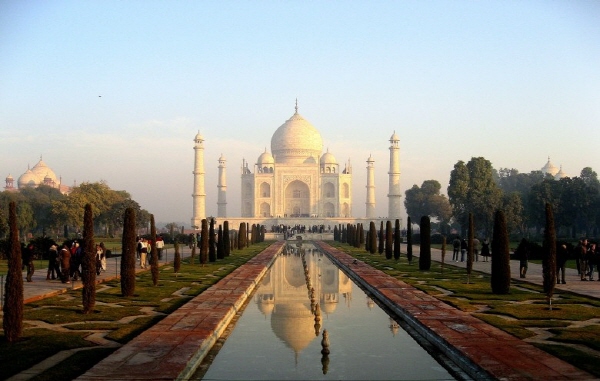
당시 무굴제국의 대칭 건축구조를 그대로 반영한 타지마할은 출입구부터 본관인 묘궁까지 모두 중앙의 연못을 중심으로 아치와 입면이 완벽한 대칭을 이룬다. 크게는 흰 대리석으로 만든 본관 묘궁과 동과 서 양쪽의 붉은 사암 건물이 양립하도록 서 있어 색감과 배치 모두에서 안정적이고 웅장한 조화를 자아낸다. 서쪽에 위치한 건물은 이슬람교의 예배당인 모스크로 사용하였으나 동쪽 건물은 아무런 기능이 없다. 그럼에도 불구하고 이 거대한 건물을 동쪽에 세운 이유는 단 하나, 묘궁을 중심으로 동서남북 어디에서든지 완벽한 대칭적 균형을 이루기 위해서이다. 하지만 이런 완벽함 속에 옥에 티를 찾는 재미도 쏠쏠하다.
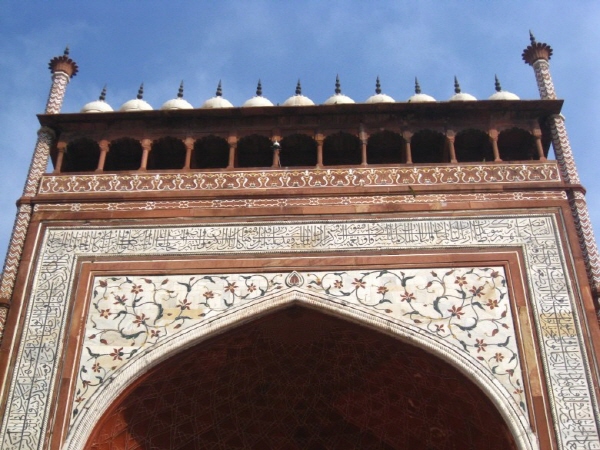

또한 출입구와 묘궁 중앙에 새겨져 있는 아랍어는 코란에서 발췌한 내용들인데 전부 모양이 다른 각각의 문자이다. 그 중에는 세계가 멸망하고
심판의 날이 다가오면 문타즈와 샤 자한 부부가 부활할 것이라는 예언적 내용도 적혀 있다고 한다. 그리고 또 하나는 동서남북 네 개 방향에 세워진
50m의 탑 미나레트이다. 이 탑이 사방에서 중심의 묘궁을 받치는 느낌 때문에 타지마할이 더욱 웅장하고 권위적으로 보이는 것인데, 멀리서 자세히
보면 이 미나레트가 피사의 사탑처럼 바깥쪽으로 조금씩 휘어져 있다. 당시 자연재해가 잦았던 시대상을 반영하여 지진으로 높은 미나레트 탑이
무너져도 중심의 묘궁은 피해를 입지 않도록 일부러 밖으로 기울어지도록 제작한 것이다. 대칭에 대한 집착으로 커다란 조형물도 거침없이 짓는 한편,
인간에게 불가항력적인 자연에 대해서는 슬기롭게 대처하는 그들의 모습에 감탄이 나온다.
둘째,
건설에 사용된 어마어마한 양의 대리석을 무려 400km나 떨어진 자이푸르(Jaipur)지방에서 운반해 사용했기 때문이다.
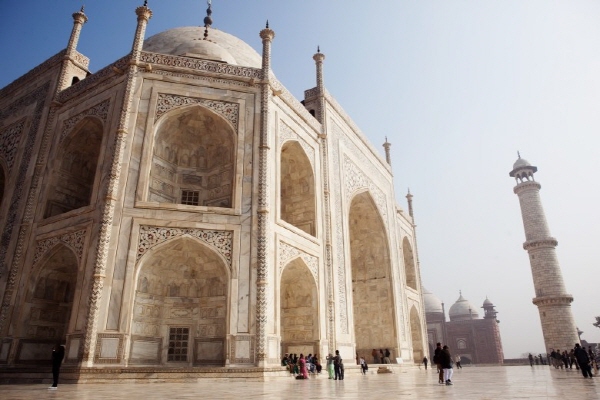
또한 지진 피해를 최소화하기 위해 기반 전량을 아프리카 나무로 사용하였다. 실제로 무굴제국 제3대 황제 악바르 대왕이 머무른 시크리 성이
무너질 때, 타지마할은 건재하였다고 한다. 22년간 매일 2만여 명의 인부들이 동원되다 보니, 공사현장에는 이들로 구성된 타자간지라는 이름의
새로운 도시가 만들어졌다. 이렇게 큰 규모의 공사는 세계에서도 드문 경우인데, 인간의 한계를 넘어선 공사 규모와 이에 투자된 천문학적인 비용과
인력 때문에 불가사의의 건축물로 꼽는 것이다.
셋째, 자체의 아름다움이다.

물론 규모나 역사에 있어서는 이집트 피라미드와 같은 유적지가 우수하겠지만 미학적인 면에 있어서는 타지마할을 따라올 건축물이 없다. 이 때문에 타지마할을 세계에서 가장 아름다운 대리석 건물로 칭한다. 흰 대리석은 밤에는 달빛이 반사되어 옅은 분홍색을 띄고, 낮에는 보석 장식들의 빛을 반사하여 천연의 빛이 스민다. 곳곳을 아름답게 장식한 보석은 아프가니스탄의 사파이어, 중국의 수정, 티베트의 터키석 등으로 지역과 나라를 가리지 않고 최고급의 천연석만을 사용하였다. 이 들은 모두 대리석이 만들어질 때부터 함께였던 것처럼 작은 틈 하나 없이 박혀 있는데 바로 피에트라 듀라(Pietra Dura)라는 모자이크 기법이라고 한다. 이 기법은 르네상스시대 유럽의 건축물에서도 발견되는 양식인데 대리석에 문양을 판 뒤 그 홈에 보석을 끼워 넣는 형식이다. 이 때문에 5백년의 세월이 지나도 홈에서 떨어지지 않고 건재함을 과시한다.

▲ 피에트라 듀라(Pietra Dura) 모자이크 기법
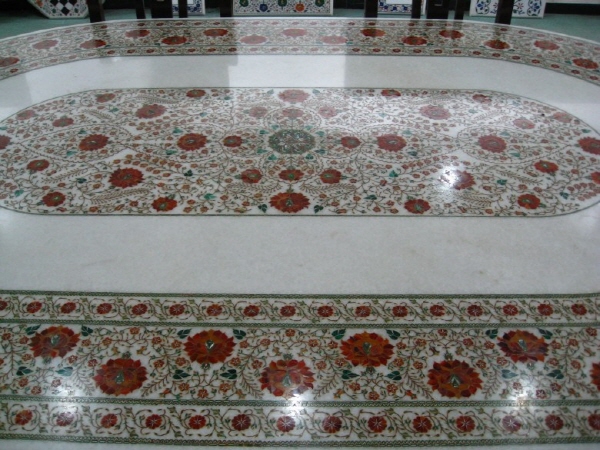
▲ 인도 쇼핑 샵에서 본 피에트라 듀라 양식으로 만든 테이블. 살 수도, 가지고 올 수도 없는 어마어마한 것이었지만, 아직까지도 눈에 밟힌다.
안타까운 것은
타지마할은 원래 갖가지 금은보화 장식으로 극도로 여성적인 화려함을 자랑했었다고 한다. 하지만 영국 식민시대를 거치며 돔을 장식하는 금장식도
사라졌고 입구를 지탱하던 은문도 뺏기는 등 수많은 약탈을 당했다고 한다. 지금보다 더 아름다울 수 있다니! 완공 당시의 타지마할을 아쉽게 상상을
해 본다.
4. 숨겨진 감상 Point
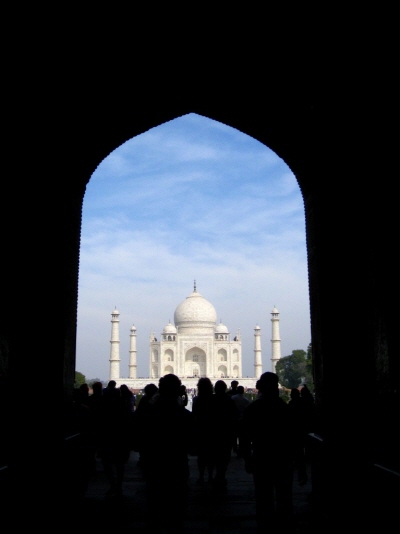
타지마할로 입장하는 입구를 그냥 지나치지 말자! 샤 자한 왕의 애틋함을 온몸으로 통감시켜 줄 신비한 체험이 숨어 있다. 우선 타지마할로 내려서는 계단을 1.5m 정도 앞에 두고 똑바로 선다. 그리고 타지마할 건물을 응시한 채로 종종 걸음으로 다가가 보자. 신기하게도 다가가면 갈수록 타지마할이 나에게서 점점 멀어진다. 샤 자한 왕의 부인을 향한 진한 그리움과 잡을 수 없는 사랑의 아련함이 이후 감상의 깊이를 더해 줄 것이다.
Taj Mahal
| Taj Mahal تاج محل | |
|---|---|
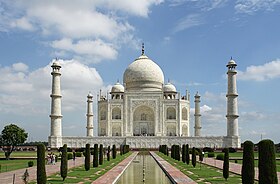 Southern view of the Taj Mahal. | |
| Location | Agra, Uttar Pradesh, India |
| Coordinates | |
| Height | 73 m (240 ft) |
| Built | 1632–1653[1] |
| Architect | Ustad Ahmad Lahauri |
| Architectural style(s) | Mughal architecture |
| Visitation | More than 3 million (in 2003) |
| Type | Cultural |
| Criteria | i |
| Designated | 1983 (7th session) |
| Reference no. | 252 |
| State Party | India |
| Region | Asia-Pacific |
The Taj Mahal (/ˌtɑːdʒ məˈhɑːl/, more often /ˈtɑːʒ/;,[2] from Persian and Arabic,[3][4] "crown of palaces", pronounced [ˈt̪aːdʒ mɛˈɦɛl]; also "the Taj"[5]) is a white marble mausoleum located in Agra, Uttar Pradesh, India.
Commissioned in 1632 by the Mughal emperor Shah Jahan to house the worldly remains of his third wife, Mumtaz Mahal, the Taj Mahal stands on the southern bank of the Yamuna River. The mausoleum is widely recognized as "the jewel of Muslim art in India" and remains as one of the world’s most celebrated structures and a symbol of India’s rich history.[6]
Regarded by many as the best example of the Mughal architecture, it is a perfect blend combining elements from Islamic, Persian, Ottoman Turkish as well as Indian architectural styles.[7][8]
The famed mausoleum complex of white domed marble of the Taj Mahal, it actually is an integrated complex of many structures. The construction began around 1632 and was completed around in 22 years, in 1653, employing around 20,000 artisans and craftsmen throughout the empire.[9] The construction was entrusted to a board of architects, the chief architect probably being Ustad Ahmad Lahauri, an Indian of Persian descent.[10][11][12][13]
Designated a UNESCO World Heritage Site in 1983, Taj Mahal attracts some 3 million people a year for visit.[14][15]
Contents
[hide]Origin and inspiration
In 1631, Shah Jahan, emperor during the Mughal empire's period of greatest prosperity, was grief-stricken when his third wife, Mumtaz Mahal, a Persian princess, died during the birth of their 14th child, Gauhara Begum.[16] Construction of the Taj Mahal began in 1632.[17] The court chronicles of Shah Jahan's grief illustrate the love story traditionally held as an inspiration for Taj Mahal.[18][19] The principal mausoleum was completed in 1648 and the surrounding buildings and garden were finished about five years later. The Emperor himself described the Taj in these words:
Should guilty seek asylum here,
Like one pardoned, he becomes free from sin.
Should a sinner make his way to this mansion,
All his past sins are to be washed away.
The sight of this mansion creates sorrowing sighs;
And the sun and the moon shed tears from their eyes.
In this world this edifice has been made;
To display thereby the creator's glory.[20]
The Taj Mahal incorporates and expands on design traditions of Persian architecture and earlier Mughal architecture. Specific inspiration came from successful Timurid and Mughal buildings including; the Gur-e Amir (the tomb of Timur, progenitor of the Mughal dynasty, in Samarkand),[21]Humayun's Tomb, Itmad-Ud-Daulah's Tomb (sometimes called the Baby Taj), and Shah Jahan's own Jama Masjid in Delhi. While earlier Mughal buildings were primarily constructed of red sandstone, Shah Jahan promoted the use of white marble inlaid with semi-precious stones, and buildings under his patronage reached new levels of refinement.[22]
Tomb
The tomb is the central focus of the entire complex of the Taj Mahal. It is a large, white marble structure standing on a square plinth and consists of a symmetrical building with an iwan (an arch-shaped doorway) topped by a large dome and finial. Like most Mughal tombs, the basic elements are Persian in origin.
The base structure is a large, multi-chambered cube with chamfered corners, forming an unequal eight-sided structure that is approximately 55 metres (180 ft) on each of the four long sides. On each of these sides, a huge pishtaq, or vaulted archway, frames the iwan with two similarly shaped, arched balconies stacked on either side. This motif of stacked pishtaqs is replicated on the chamfered corner areas, making the design completely symmetrical on all sides of the building. Four minarets frame the tomb, one at each corner of the plinth facing the chamfered corners. The main chamber houses the false sarcophagi of Mumtaz Mahal and Shah Jahan; the actual graves are at a lower level.
The marble dome that surmounts the tomb is the most spectacular feature. Its height of around 35 metres (115 ft) is about the same as the length of the base, and is accentuated as it sits on a cylindrical "drum" which is roughly 7 metres (23 ft) high. Because of its shape, the dome is often called an onion dome or amrud (guava dome). The top is decorated with a lotus design, which also serves to accentuate its height. The shape of the dome is emphasized by four smaller domed chattris (kiosks) placed at its corners, which replicate the onion shape of the main dome. Their columned bases open through the roof of the tomb and provide light to the interior. Tall decorative spires (guldastas) extend from edges of base walls, and provide visual emphasis to the height of the dome. The lotus motif is repeated on both the chattris and guldastas. The dome and chattris are topped by a gilded finial, which mixes traditional Persian and Hindustani decorative elements.
The main finial was originally made of gold but was replaced by a copy made of gilded bronze in the early 19th century. This feature provides a clear example of integration of traditional Persian and Hindu decorative elements. The finial is topped by a moon, a typical Islamic motif whose horns point heavenward.[9]
The minarets, which are each more than 40 metres (130 ft) tall, display the designer's penchant for symmetry. They were designed as working minarets—a traditional element of mosques, used by the muezzin to call the Islamic faithful to prayer. Each minaret is effectively divided into three equal parts by two working balconies that ring the tower. At the top of the tower is a final balcony surmounted by a chattri that mirrors the design of those on the tomb. The chattris all share the same decorative elements of a lotus design topped by a gilded finial. The minarets were constructed slightly outside of the plinth so that, in the event of collapse, (a typical occurrence with many tall constructions of the period) the material from the towers would tend to fall away from the tomb.
- General views
View from Mosque
Exterior decoration
The exterior decorations of the Taj Mahal are among the finest in Mughal architecture. As the surface area changes the decorations are refined proportionally. The decorative elements were created by applying paint, stucco, stone inlays, or carvings. In line with the Islamic prohibition against the use of anthropomorphic forms, the decorative elements can be grouped into either calligraphy, abstract forms or vegetative motifs.
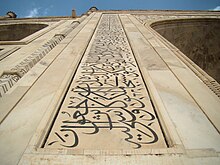
Throughout the complex, passages from the Qur'an are used as decorative elements. Recent scholarship suggests that the passages were chosen by Amanat Khan.[23][24] The texts refer to themes of judgment and include:
Surah 36 – Ya Sin
Surah 39 – Az-Zumar The Crowds
Surah 48 – Al-Fath Victory
Surah 67 – Al-Mulk Dominion
Surah 77 – Al-Mursalat Those Sent Forth
Surah 81 – At-Takwir The Folding Up
Surah 82 – Al-Infitar The Cleaving Asunder
Surah 84 – Al-Inshiqaq The Rending Asunder
Surah 89 – Al-Fajr Daybreak
Surah 91 – Ash-Shams The Sun
Surah 93 – Ad-Dhuha Morning Light
Surah 94 – Al-Inshirah The Solace
Surah 95 – At-Teen The Fig
Surah 98 – Al-Bayyinah The Evidence
Surah 112 – Al-Ikhlas The Purity of Faith
The calligraphy on the Great Gate reads "O Soul, thou art at rest. Return to the Lord at peace with Him, and He at peace with you."[24]
The calligraphy was created by a calligrapher named Abd ul-Haq, in 1609. Shah Jahan conferred the title of "Amanat Khan" upon him as a reward for his "dazzling virtuosity".[10] Near the lines from the Qur'an at the base of the interior dome is the inscription, "Written by the insignificant being, Amanat Khan Shirazi."[25] Much of the calligraphy is composed of florid thuluth script, made of jasper or black marble,[10] inlaid in white marble panels. Higher panels are written in slightly larger script to reduce the skewing effect when viewed from below. The calligraphy found on the marble cenotaphs in the tomb is particularly detailed and delicate.
Abstract forms are used throughout, especially in the plinth, minarets, gateway, mosque, jawab and, to a lesser extent, on the surfaces of the tomb. The domes and vaults of the sandstone buildings are worked with tracery of incised painting to create elaborate geometric forms. Herringbone inlays define the space between many of the adjoining elements. White inlays are used in sandstone buildings, and dark or black inlays on the white marbles. Mortared areas of the marble buildings have been stained or painted in a contrasting colour, creating geometric patterns of considerable complexity. Floors and walkways use contrasting tiles or blocks in tessellation patterns.
On the lower walls of the tomb there are white marble dados that have been sculpted with realistic bas relief depictions of flowers and vines. The marble has been polished to emphasise the exquisite detailing of the carvings and the dado frames and archway spandrels have been decorated with pietra dura inlays of highly stylised, almost geometric vines, flowers and fruits. The inlay stones are of yellow marble, jasper and jade, polished and levelled to the surface of the walls.
Calligraphy of Persian poems
Interior decoration
The interior chamber of the Taj Mahal steps far beyond traditional decorative elements. Here, the inlay work is not pietra dura, but a lapidary of precious and semiprecious gemstones. The inner chamber is an octagon with the design allowing for entry from each face, although only the door facing the garden to the south is used.
The interior walls are about 25 metres (82 ft) high and are topped by a "false" interior dome decorated with a sun motif. Eight pishtaq arches define the space at ground level and, as with the exterior, each lower pishtaq is crowned by a second pishtaq about midway up the wall. The four central upper arches form balconies or viewing areas, and each balcony's exterior window has an intricate screen or ''jali'' cut from marble. In addition to the light from the balcony screens, light enters through roof openings covered by chattris at the corners. Each chamber wall has been highly decorated with dado bas-relief, intricate lapidary inlay and refined calligraphy panels, reflecting in miniature detail the design elements seen throughout the exterior of the complex.
The octagonal marble screen or 'jali' which borders the cenotaphs is made from eight marble panels which have been carved through with intricate pierce work. The remaining surfaces have been inlaid in extremely delicate detail with semi-precious stones forming twining vines, fruits and flowers.
Muslim tradition forbids elaborate decoration of graves. Hence, the bodies of Mumtaz and Shah Jahan were put in a relatively plain crypt beneath the inner chamber with their faces turned right and towards Mecca. Mumtaz Mahal's cenotaph is placed at the precise centre of the inner chamber on a rectangular marble base of 1.5 by 2.5 metres (4 ft 11 in by 8 ft 2 in).
Both the base and casket are elaborately inlaid with precious and semiprecious gems. Calligraphic inscriptions on the casket identify and praise Mumtaz. On the lid of the casket is a raised rectangular lozenge meant to suggest a writing tablet. Shah Jahan's cenotaph is beside Mumtaz's to the western side, and is the only visible asymmetric element in the entire complex. His cenotaph is bigger than his wife's, but reflects the same elements: a larger casket on a slightly taller base, again decorated with astonishing precision with lapidary and calligraphy that identifies him. On the lid of this casket is a traditional sculpture of a small pen box.
The pen box and writing tablet were traditional Mughal funerary icons decorating the caskets of men and women respectively. The Ninety Nine Names of God are found as calligraphic inscriptions on the sides of the actual tomb of Mumtaz Mahal, in the crypt including "O Noble, O Magnificent, O Majestic, O Unique, O Eternal, O Glorious... ". The tomb of Shah Jahan bears a calligraphic inscription that reads; "He travelled from this world to the banquet-hall of Eternity on the night of the twenty-sixth of the month of Rajab, in the year 1076 Hijri."
Detail of Pietra dura jali inlay
Garden
The complex is set around a large 300-metre (980 ft) square charbagh or Mughal garden. The garden uses raised pathways that divide each of the four quarters of the garden into 16 sunken parterres or flowerbeds. A raised marble water tank at the center of the garden, halfway between the tomb and gateway with a reflecting pool on a north-south axis, reflects the image of the mausoleum. The raised marble water tank is called al Hawd al-Kawthar, in reference to the "Tank of Abundance" promised to Muhammad.[26]
Elsewhere, the garden is laid out with avenues of trees and fountains. The charbagh garden, a design inspired by Persian gardens, was introduced to India by the first Mughal emperor, Babur. It symbolises the four flowing rivers of Jannah (Paradise) and reflects the Paradise garden derived from the Persian paridaeza, meaning 'walled garden'. In mystic Islamic texts of Mughal period, Paradise is described as an ideal garden of abundance with four rivers flowing from a central spring or mountain, separating the garden into north, west, south and east.
Most Mughal charbaghs are rectangular with a tomb or pavilion in the center. The Taj Mahal garden is unusual in that the main element, the tomb, is located at the end of the garden. With the discovery of Mahtab Bagh or "Moonlight Garden" on the other side of the Yamuna, the interpretation of the Archaeological Survey of India is that the Yamuna river itself was incorporated into the garden's design and was meant to be seen as one of the rivers of Paradise.[27] The similarity in layout of the garden and its architectural features with the Shalimar Gardens suggest that they may have been designed by the same architect, Ali Mardan.[28] Early accounts of the garden describe its profusion of vegetation, including abundant roses, daffodils, and fruit trees.[29] As the Mughal Empire declined, the tending of the garden also declined, and when the British took over the management of Taj Mahal during the time of the British Empire, they changed the landscaping to resemble that of lawns of London.[30]
Outlying buildings
The Taj Mahal complex is bounded on three sides by crenellated red sandstone walls, with the river-facing side left open. Outside the walls are several additional mausoleums, including those of Shah Jahan's other wives, and a larger tomb for Mumtaz's favourite servant.[31]
The main gateway (darwaza) is a monumental structure built primarily of marble which is reminiscent of Mughal architecture of earlier emperors. Its archways mirror the shape of tomb's archways, and its pishtaq arches incorporate the calligraphy that decorates the tomb. The vaulted ceilings and walls have elaborate geometric designs, like those found in the other sandstone buildings of the complex.[32]
At the far end of the complex, there are two grand red sandstone buildings that face the sides of the tomb. Their backs parallel the western and eastern walls, and the two buildings are precise mirror images of each other. The western building is a mosque and the other is the jawab (answer), whose primary purpose was architectural balance, although it may have been used as a guesthouse. The distinctions between these two buildings include the lack of mihrab (a niche in a mosque's wall facing Mecca) in the jawab and that the floors of jawab have a geometric design, while the mosque floor was laid with outlines of 569 prayer rugs in black marble. The mosque's basic design of a long hall surmounted by three domes is similar to others built by Shah Jahan, particularly to his Masjid-Jahan Numa, or Jama Masjid, Delhi. The Mughal mosques of this period divide the sanctuary hall into three areas, with a main sanctuary and slightly smaller sanctuaries on either side. At the Taj Mahal, each sanctuary opens onto an enormous vaulting dome. These outlying buildings were completed in 1643.[33]
Construction
The Taj Mahal is built on a parcel of land to the south of the walled city of Agra. Shah Jahan presented Maharajah Jai Singh with a large palace in the center of Agra in exchange for the land.[34] An area of roughly three acres was excavated, filled with dirt to reduce seepage, and leveled at 50 metres (160 ft) above riverbank. In the tomb area, wells were dug and filled with stone and rubble to form the footings of the tomb. Instead of lashed bamboo, workmen constructed a colossal brick scaffold that mirrored the tomb. The scaffold was so enormous that foremen estimated it would take years to dismantle.[35]
According to the legend, Shah Jahan decreed that anyone could keep the bricks taken from the scaffold, and thus it was dismantled by peasants overnight. A fifteen kilometer (9.3 mi) tamped-earth ramp was built to transport marble and materials to the construction site and teams of twenty or thirty oxen pulled the blocks on specially constructed wagons.[36] An elaborate post-and-beam pulley system was used to raise the blocks into desired position. Water was drawn from the river by a series of purs, an animal-powered rope and bucket mechanism, into a large storage tank and raised to a large distribution tank. It was passed into three subsidiary tanks, from which it was piped to the complex.
The plinth and tomb took roughly 12 years to complete. The remaining parts of the complex took an additional 10 years and were completed in order of minarets, mosque and jawab, and gateway. Since the complex was built in stages, discrepancies exist in completion dates due to differing opinions on "completion". For example, the mausoleum itself was essentially complete by 1643, but work continued on the rest of the complex. Estimates of the cost of construction vary due to difficulties in estimating costs across time. The total cost has been estimated to be about 32 million Rupees at that time.[37]

The Taj Mahal was constructed using materials from all over India and Asia and over 1,000 elephants were used to transport building materials. The translucent white marble was brought from Makrana, Rajasthan, the jasper from Punjab, jade and crystal from China. The turquoise was from Tibet and the Lapis lazuli from Afghanistan, while the sapphire came from Sri Lanka and the carnelian from Arabia. In all, twenty eight types of precious and semi-precious stones were inlaid into the white marble.
The construction of the Taj Mahal was entrusted to a board of architects under imperial supervision, including Abd ul-Karim Ma'mur Khan, Makramat Khan, and Ustad Ahmad Lahauri.[10][38] Lahauri[11] is generally considered to be the principal designer.[12]
A labour force of twenty thousand workers was recruited across northern India. Sculptors from Bukhara, calligraphers from Syria and Persia, in-layers from southern India, stone cutters from Baluchistan, a specialist in building turrets, another who carved only marble flowers were part of the thirty-seven men who formed the creative unit. Some of the builders involved in construction of Taj Mahal are:
- Ismail Afandi (a.k.a. Ismail Khan) - had previously worked for the Ottoman Sultan and is regarded by some as the designer of the main dome.[39]
- Ustad Isa, born either in Shiraz, Ottoman Empire or Agra – credited with a key role in the architectural design and main dome.[40]
- 'Puru' from Benarus, Persia – has been mentioned as a supervising architect.[41]
- Qazim Khan, a native of Lahore – cast the solid gold finial.
- Chiranjilal, a lapidary from Delhi – the chief sculptor and mosaicist.
- Amanat Khan from Shiraz, Iran – the chief calligrapher.[42]
- Muhammad Hanif – a supervisor of masons.
- Mir Abdul Karim and Mukkarimat Khan of Shiraz – handled finances and management of daily production.
History

Abdul Hamid Lahauri, the author of the Badshahnama, the official history of Shah Jahan's reign, calls Taj Mahal rauza-i munawwara, which means the illumined or illustrious tomb.[43]
Soon after the Taj Mahal's completion, Shah Jahan was deposed by his son Aurangzeb and put under house arrest at nearby Agra Fort. Upon Shah Jahan's death, Aurangzeb buried him in the mausoleum next to his wife.[44]
In the 18th century, the Jat rulers of Bharatpur invaded Agra and attacked the Taj Mahal, the two chandeliers, one of agate and another of silver, which were hung over the main cenotaph, were taken away by them, also the gold and silver screen. According to Mughal historian Kanbo, the 15-foot high finial at the top of the main dome of the Taj Mahal was covered with a gold shield and this was also removed during the Jat despoliation.[45]
By the late 19th century, parts of the buildings had fallen badly into disrepair. During the time of the Indian rebellion of 1857, the Taj Mahal was defaced by British soldiers and government officials, who chiselled out precious stones and lapis lazuli from its walls. At the end of the 19th century, British viceroy Lord Curzon ordered a sweeping restoration project, which was completed in 1908.[46][47] He also commissioned the large lamp in the interior chamber, modelled after one in a Cairo mosque. During this time the garden was remodelled with British-style lawns that are still in place today.[30]
Threats
In 1942, the government erected a scaffolding in anticipation of an air attack by Japanese Air Force.[48][49] During the India-Pakistan wars of 1965 and 1971, scaffoldings were again erected to mislead bomber pilots.[50]
More recent threats have come from environmental pollution on the banks of Yamuna River including acid rain[51] due to the Mathura Oil Refinery,[52] which was opposed by Supreme Court of India directives.[53] The pollution has been turning the Taj Mahal yellow. To help control the pollution, the Indian government has set up the Taj Trapezium Zone (TTZ), a 10,400-square-kilometre (4,000 sq mi) area around the monument where strict emissions standards are in place.[54]
Concerns for the tomb's structural integrity have recently been raised because of a decline in the groundwater level in the Yamuna river basin which is falling at a rate of around 5 feet a year. In 2010, cracks appeared in parts of the tomb, and the minarets which surround the monument were showing signs of tilting, as the wooden foundation of the tomb may be rotting due to lack of water. In 2011 it was reported that some predictions indicated that the tomb could collapse within 5 years.[55][56]
Tourism
The Taj Mahal attracts a large number of tourists. UNESCO documented more than 2 million visitors in 2001, including more than 200,000 from overseas.[57] A two tier pricing system is in place, with a significantly lower entrance fee for Indian citizens and a more expensive one for foreigners. Most tourists visit in the cooler months of October, November and February. Polluting traffic is not allowed near the complex and tourists must either walk from parking lots or catch an electric bus. The Khawasspuras (northern courtyards) are currently being restored for use as a new visitor center.[58][59]
The small town to the south of the Taj, known as Taj Ganji or Mumtazabad, was originally constructed with caravanserais, bazaars and markets to serve the needs of visitors and workmen.[60] Lists of recommended travel destinations often feature the Taj Mahal, which also appears in several listings of seven wonders of the modern world, including the recently announced New Seven Wonders of the World, a recent poll[61] with 100 million votes.
The grounds are open from 06:00 to 19:00 weekdays, except for Friday when the complex is open for prayers at the mosque between 12:00 and 14:00. The complex is open for night viewing on the day of the full moon and two days before and after,[62] excluding Fridays and the month of Ramadan. For security reasons[63] only five items—water in transparent bottles, small video cameras, still cameras, mobile phones and small ladies' purses—are allowed inside the Taj Mahal.[64]
Myths
Ever since its construction, the building has been the source of an admiration transcending culture and geography, and so personal and emotional responses have consistently eclipsed scholastic appraisals of the monument.[65]
A longstanding myth holds that Shah Jahan planned a mausoleum to be built in black marble as a Black Taj Mahal across the Yamuna river.[66] The idea originates from fanciful writings of Jean-Baptiste Tavernier, a European traveller who visited Agra in 1665. It was suggested that Shah Jahan was overthrown by his son Aurangzeb before it could be built. Ruins of blackened marble across the river in Moonlight Garden, Mahtab Bagh, seemed to support this legend. However, excavations carried out in the 1990s found that they were discolored white stones that had turned black.[67] A more credible theory for the origins of the black mausoleum was demonstrated in 2006 by archaeologists who reconstructed part of the pool in the Moonlight Garden. A dark reflection of the white mausoleum could clearly be seen, befitting Shah Jahan's obsession with symmetry and the positioning of the pool itself.[68]
No evidence exists for claims that describe, often in horrific detail, the deaths, dismemberments and mutilations which Shah Jahan supposedly inflicted on various architects and craftsmen associated with the tomb. Some stories claim that those involved in construction signed contracts committing themselves to have no part in any similar design. Similar claims are made for many famous buildings.[69] No evidence exists for claims that Lord William Bentinck, governor-general of India in the 1830s, supposedly planned to demolish the Taj Mahal and auction off the marble. Bentinck's biographer John Rosselli says that the story arose from Bentinck's fund-raising sale of discarded marble from Agra Fort.[70]
Another myth suggests that beating the silhouette of the finial will cause water to come forth. To this day, officials find broken bangles surrounding the silhouette.[71]
In 2000, India's Supreme Court dismissed P. N. Oak's petition[72] to declare that a Hindu king built the Taj Mahal.[69][73] In 2005 a similar petition was dismissed by the Allahabad High Court. This case was brought by Amar Nath Mishra, a social worker and preacher who says that the Taj Mahal was built by the Hindu King Parmar Dev in 1196.[74]
Replicas
Among the buildings modelled on the Taj Mahal are the Taj Mahal Bangladesh, the Bibi Ka Maqbara in Aurangabad, Maharashtra, the Trump Taj Mahal in Atlantic City, NJ and the Tripoli Shrine Temple in Milwaukee, Wisconsin.
Bibi Ka Maqbara (1651-1661) in Aurangabad is a another Mughal monument.
Tripoli Shrine Temple (1928)
Trump Taj Mahal (1990)
Mausoleum of Zulfikar Ali Bhutto in Garhi Khuda Bakhsh, Sindh, Pakistan (1993-1997)
Taj Mahal Bangladesh (2008)
Siddiqa Fatima Zahra Mosque, Kuwait (2008-2011)
Gallery
- Taj Mahal Gallery
View from the river Yamuna
Tamga of the Mughal Empire on top of the Taj Mahal.
Depiction of Taj Mahal by orientalist painter Edwin Lord Weeks. The Walters Art Museum.










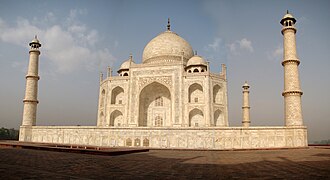








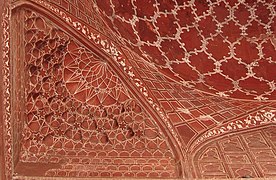
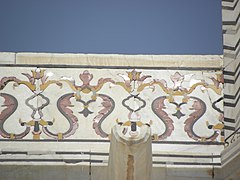










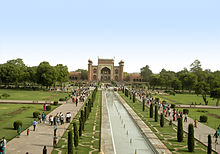
















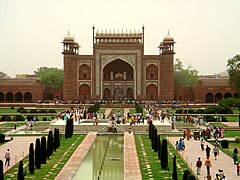
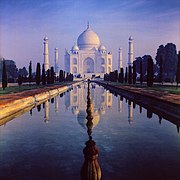
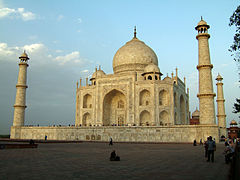



1. 인도 : 촌락지
2. 인도네시아 : (값이) 비싸다
3. 필리핀 타갈로그어 : 사랑